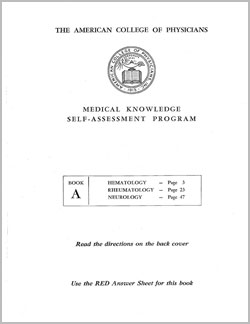In April of 1966, the American College of Physicians’ Board of Regents (BOR) was presented with a report from its Educational Activities Committee (EAC). The report indicated that a percentage of physicians’ research of the prevailing medical literature was both “ineffective and unproductive,” and therefore would not lead toward better patient practices. The EAC findings discussed the issue of residents with outstanding training backgrounds still doing poorly on their American Board of Internal Medicine (ABIM) written examinations. Because the ABIM testing did not offer results which would demonstrate areas of weakness, candidates who took the certification examination were confused about those areas of medical knowledge and training in which they were deficient. Many ACP members also reported that they could not keep up with the “flood” of new medical information. Consequently, the EAC advocated the creation of a continuing medical education program for internal medicine physicians, arguing that it should become a major focus of the College.
The Chairman of the EAC, Dr. Hugh R. Butt, suggested that the major concern of most members was a lack of “guidance” over what a “practicing physician” should study. Dr. Butt (whose studies of coagulation a generation earlier showed that Vitamin K could be highly effective in halting internal bleeding) called for ACP to establish a system of self-testing, to enable doctors to refresh their knowledge in private and without having to reveal their test results. After a series of further discussions and continued research, the College began work on its first Medical Knowledge Self-Assessment Program (MKSAP) in late 1966. Dr. Butt selected “subspecialty chairmen” in nine medical fields: neurology, cardiovascular disease, gastroenterology, pulmonary disease, hematology, rheumatology, endocrinology and metabolism, renal disease, infectious disease and immunology. Each subspecialty chairman then selected a subcommittee of five with at least one general internal medicine physician per group to emphasize “clinical practice.”
MKSAP I Sold Over 12,000 Copies
These MKSAP subcommittees met throughout 1967, discussing the design of the self-assessment test and the specifics of the type of questions chosen. Test questions and a prospectus outlining the program, along with a registration form, were sent out to members in October 1967. MKSAP 1 was scheduled for a release in January 1968, at a preorder cost of $10 for members, $25 for member orders after initial publication, and $25 for non-members. By December 1967, 4,500 pre-order applications were received by the College, and through 1971 a total of 12,130 copies of MKSAP 1 were sold. Follow-up responses from the self-assessment participants were extremely positive. Most respondents considered the MKSAP as an outstanding educational tool and defined the experience as “challenging and humbling.”

The College received a great deal of favorable publicity for the introduction of MKSAP. The self-assessment program was purchased for residency programs and departments of medicine as an aid in teaching both medical students and medical school graduates. MKSAP also served as an inspiration for several peer medical associations, which informed ACP Headquarters that they would be creating a similar program for their particular field. Dr. Butt described the responses from practitioners as demonstrating that internal medicine physicians were “conscientious” about continuing education and would “engage in self-appraisal without coercion.” As a result of continuing interest in the program, the BOR voted to repeat and revise MKSAP every three years.
As new editions have developed, MKSAP has changed and grown in a variety of ways to meet the needs of medical practitioners. The first two editions of MKSAP only contained self-assessment questions, with accompanying answers and critiques. It was not until MKSAP 3 that a 134 page text-based syllabus was included. Currently the syllabus is 1,012 pages. While MKSAP 1 contained 720 multiple-choice questions, the current edition has 1,094. The first edition of MKSAP had a total of 12,130 print sales, while the last edition that completed its sales cycle (MKSAP 17) sold 35,667 print and electronic packages. Currently in its 8th edition, MKSAP continues to serve as a highly valued, comprehensive review of internal medicine and its subspecialties.
Sources:
- Prepared by Eric Greenberg, based on materials from the Archives of the American College of Physicians
- Rosenow EC Jr. History of the American College of Physicians: Executive Perspectives, 1959-1977. Philadelphia: American College of Physicians; 1984.
- Tooker, John, and David C. Dale. Serving Our Patients and Profession: a Centennial History of the American College of Physicians (1915-2015). American College of Physicians, 2015

